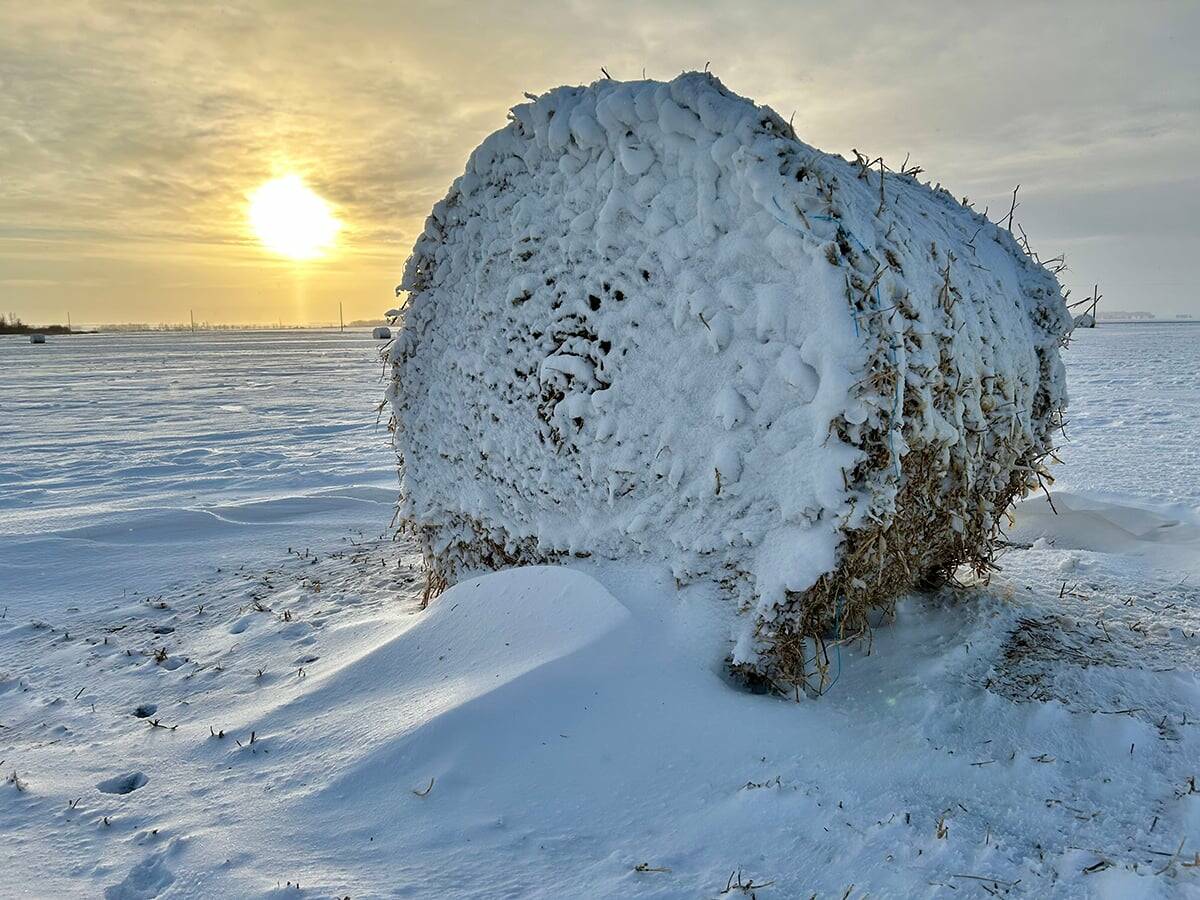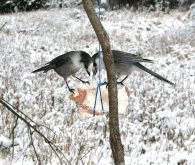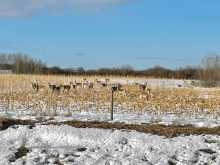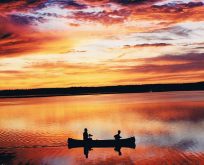Except for a few late-season big game draw hunts currently playing out, most hunters in Manitoba have put away their gear and switched their focus to other winter outdoor pursuits and interesting wild game meals.
Looking back, 2024 yielded a mixed bag for grouse, duck and deer hunters in Manitoba.
Why it matters: Manitoba enjoys a robust hunting scene, with many farmers looking to fill a deer tag after crops are off the field.
Read Also

What is perfect Christmas weather?
What is ‘perfect’ Christmas weather on the Prairies? Here’s where you should head this holiday, according to historical weather data.
Late last summer, my predictions for the 2024 hunting season were based mostly on the major weather trends. Rain, snow and cold have major impacts on the species most commonly hunted.
The warm, dry 2023-2024 winter left us a bit unprepared for the late, wet spring and rains that carried into summer in many areas. I expected grouse to be negatively affected by the spring rains, but I also thought duck populations would be down because the moisture came too late to stimulate a large breeding effort. By comparison, geese experienced favourable breeding conditions locally and in the Arctic. It was also an easy call to predict that deer hunters would see a significant uptick this fall.
I’ve since canvassed a number of hunting pals, some of whom also have wildlife management experience, to see how their seasons played out.
These collected observations are nowhere near as accurate as the crop harvest estimates the Co-operator offers up to grain farmers. That said, there are consistencies in what I heard and saw myself through the autumn.

Variable grouse
Grouse numbers were below average to, at best, average in most areas, which suggests production was down. Huntable numbers of ruffed grouse could be found throughout the province, but no one I talked to reported banner hunts. In eastern Manitoba, I ended up taking a few walks through my favourite haunts and not bagging very many birds in the process.
Sharp-tailed grouse numbers were mostly down across the province, which is not surprising, as late spring rains seem to especially affect this species. I didn’t get to my favourite spots in the Westlake region of the Parkland, but I later heard that birds were also scarce there and through the Interlake. I also heard that grouse were generally down in the southwest, but one hunter reported good numbers in the southwestern corner.
Hungarian partridge numbers were interesting. They seemed to be down significantly in central Manitoba, but the southwest held good numbers. It that area, hunters reporting flushing large coveys, which are usually family groups, indicating good breeding success.

Inconsistent duck chances
With waterfowl, the relationship between breeding success and hunting opportunities breaks down from area to area, simply because these birds are so mobile during migration. They’ll usually concentrate where wetland and field-feeding conditions are to their liking and, often, it’s a story of “here today, gone tomorrow.”
Ducks were widespread, but in small numbers, across the province when the season opened in early September, though some traditional staging areas bucked the trend with good numbers of birds.
At Delta Marsh, teal and other early migrants seemed to depart not long after opening day. The marsh was pretty quiet through mid- and late-September. Good hunting for later migrants, mainly mallards and diving ducks, returned in October.
By comparison, Whitewater Lake generally held good numbers throughout the fall. I also had excellent mid-September hunts for teal in the Pembina Valley, but my hotspot cooled later in the month.
In the northern part of pothole country, closer to Riding Mountain National Park, duck numbers were up compared to the last few years. This was especially so for diving ducks, which had been fairly scarce in recent seasons.
One of my most memorable hunts occured in this area in early October. We took a limit on a less-common dabbling duck — American wigeon. We take a few wigeon in that area from time to time but, this year, a few hundred birds settled into a wetland not far from my brother’s home this fall. The attraction? The pond was brimming with a submergent plant species, Ruppia maritima, commonly called wigeon grass.

Excellent pothole and field hunts could be found in the central and southern pothole region, but you had to go looking for them.
Two different groups of hunters noted that gaining access to hunting opportunities had improved noticeably. New regulations that took full effect in 2024 limited non-Canadian, non-residents to one seven-day hunting period per season. This change was a response to non-residents establishing essentially unlicensed outfitting operations that leased large portions of the best hunting areas for the entire season. This significantly impacted local hunters as well as registered, licensed outfitters.
Based on early indications, the new regulations are having their intended effect.

High goose numbers continue
Canada geese continued to offer excellent hunting opportunities across the province. Local production of giant Canada geese looked to be high and major Arctic nesting grounds also had favourable weather during the critical nesting period.
The only quibble for the season was that our warm, extended fall seemed to delay the arrival and building of field-feeding flocks. Once here though, Canada goose hunting opportunities were widespread. Tenacious goose hunters could find good chances well into mid-November thanks to the same warm weather.
This was also true for duck hunters. One of my contacts reported a marsh mallard hunt on Nov. 17.

Snow goose migration in the last few years has been hard to pin down. Three decades ago, as snow goose numbers were exploding, hunters in Manitoba began to see that migration patterns were shifting. Once-reliable snow goose spots in central Manitoba slowly dried up, but fall numbers in Saskatchewan kept increasing.
Snow geese are still found in good numbers close to the Saskatchewan border, but the rest of the province is hit or miss. I encountered modest flocks scattered across eastern and central Manitoba, but it’s nowhere close to the numbers of 30 or 40 years ago, despite their still booming populations.
Biologists don’t have a good explanation for this shift. While I feel sorry for all the hunters who invested heavily in snow goose decoys in previous decades, we still have Canada geese galore, and I would pick them over snow geese if given the choice.
I was interested to hear that white-fronted geese, not a common sight in agro-Manitoba, came through in greater numbers in 2024. When I lived in the northern part of the province, I heard the Cree call these mid-sized geese “gigglers,” which does a pretty good job of describing their unusual call. They’re prized table fare, which I would love to test out in my kitchen.
Better deer numbers, but still mixed
Coming off an exceptionally warm and dry winter, deer hunters were looking to the 2024 season with great anticipation and more deer-tag purchase opportunities.
Hunters did generally report more deer and success, but there was some variability across the province.
White-tailed deer looked to have a good fawn crop throughout farm country, with significant numbers of twins and some triplets reported. But forested landscapes did not seem to get the same production spike.
This isn’t too surprising. Deer in agricultural areas generally have an easier time. They have access to more high-energy foods, a shorter period of snow cover and, usually, lower predation pressure.
I have hunted in the Whiteshell area for over two decades and, like in other years, I was hoping for a significant bump after a couple of lean seasons, but I think the increase was modest at best. It’s difficult to say if there was a lingering impact from past hard winters or if continuing high numbers of wolves, bears and other large predators were limiting deer numbers. Most likely, a combination of factors were at play.
The hunters I spoke to also reported decent numbers of mature bucks. They saw a good age distribution of animals, which is a good indication of healthy, growing populations.

Extended warm autumn weather may have been another factor affecting hunting opportunities. Deer are less active in good weather; there isn’t the same imperative to move and feed. If deer aren’t moving much, hunters will see fewer animals. I love to hunt deer in warmer weather, but I expect to see more animals when there is a bite in the air and snow on the ground.
I was especially interested in reports of significantly fewer mule deer along the Saskatchewan border this fall. One hunter, whose group had taken several mule deer in the Lauder area previously, reported only four of the species in the same areas this fall. His count was corroborated by the rancher on whose land he was hunting.
The generous mule deer seasons of the last couple of years may have had their desired effect. Mule deer are especially susceptible to chronic wasting disease, and containing their spread in Manitoba an important part of the province’s control strategy for the disease.
With forecasts of a colder, snowier winter, many deer hunters are a little nervous right now. Winter began with lots of snow in many areas, though warm weather in December reduced the snowpack somewhat.
Winter survival is the biggest factor affecting deer populations, and it can be simplified to a simple equation that considers the accumulation and persistence of snow and cold weather. A hard winter is a double whammy: high mortality as well as stressed does translate to fewer fawns the next spring.
There is also a general view that coyote numbers, which have been high for a while now, were even higher in fall 2024. Coyotes do take deer, especially younger animals, so these numbers, combined with a hard winter, could be a big factor in how many deer make it to spring.

Final thoughts
In the end, I have no complaints about the 2024 season.
Looking back on my own experiences and listening to those of others, I was reminded of the wealth of hunting opportunities for upland birds, for waterfowl and for deer that Manitoba offers to its citizens and visitors. This tremendous natural bounty is but one of the many reasons to live, work and play in Manitoba, especially for those who treasure encounters with nature and the chance to bring wonderful meal options to the table.
















